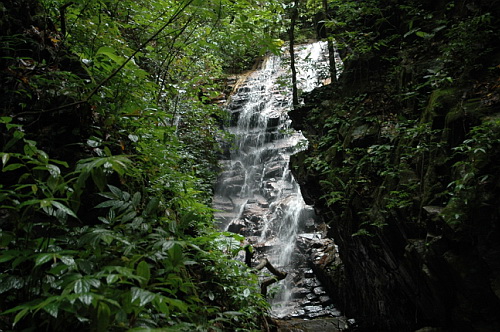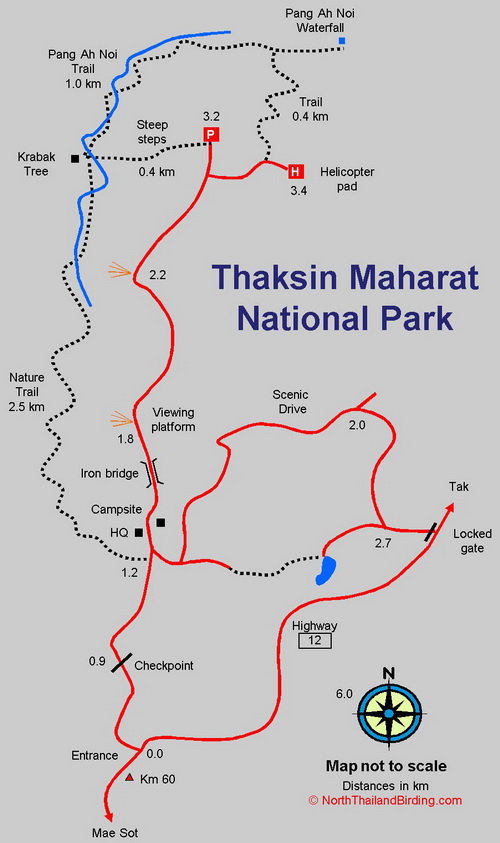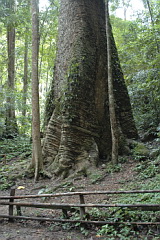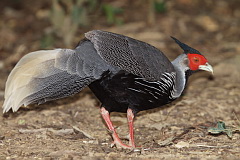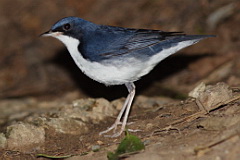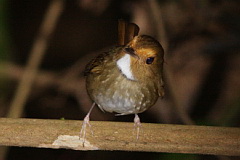Overview
Originally named Ton Krabak Yai National Park, after the massive, 700 year old Krabak tree located a few kilometres from the park entrance, the name was later changed to Thaksin Maharat to honour King Thaksin the Great. The park covers an area of 262 square kilometres, was created in 1981, and is also known for its geology. The altitude of around 800 - 1,000 metres supports both evergreen and pine forest. Information on this page verified/accurate as of 12 Mar 2023.
|
AccessThe park entrance and headquarters are located 26 kilometres, a 30 minute drive, west of Tak. From Tak, head south on Highway 1 toward Bangkok for a few kilometres, then take Highway 12 westward toward Mae Sot and the Burma border. The park, and its famous tree, are well sign posted. The entrance to Thaksin Maharat lies directly on the right hand side of Highway 12 after 25.9 kilometres, 100 metres before the Km 60 marker. Accommodation and FacilitiesAt the park HQ are a few bungalows, as well as a small camp site. Eating facilities are limited to a small restaurant that can only be relied upon to be open during busy periods; namely weekends and holidays in the cool season. Better to bring all food and water to be sure. Outside the park, accommodation is most easily found around Tak town with a fair choice of small hotels and resorts. As a sizeable town, Tak has good restaurant choices and larger supermarkets and convenience stores for stocking up.
|
Birding
Although geographically situated just inside northern Thailand, the forest type and biology of Thaksin Maharat are decidedly western forest block with a number of species shared with forests farther south, such as Rufous-browed Flycatcher, Spot-necked Babbler, Olive Bulbul and White-throated Bulbul. As the number of species likely to be encountered here is not great, and the park lies well off the usual birding routes, it has been largely ignored by both resident and visiting birders alike. With a spare day this park makes a rewarding visit and holds two species - Olive Bulbul and White-throated Bulbul - which are far easier to find here than other sites in Thailand. Inside the park is a TV relay tower, the lights of which can attract migrants at certain times of the year. Unfortunately there is also evidence that some are killed from collisions with the infrastruture.
|
Road from Entrance to Krabak Tree Parking The main access road runs from Highway 12, through the checkpoint, HQ and camping area for 3.2 kilometres, to where it ends at a parking area. This road, running along an exposed ridge, is invariably rather windy. The habitat is mostly pines and cut over secondary forest and not particularly good for birds. Just after the iron bridge is a viewing platform, on the left, with a sign "bird sanctuary" and a board depicting some common, and decidedly not so common, species such as Wreathed Hornbill that supposedly can occur. If not windy it's worth a stop here to scan the forest canopy of the valley below. Grey Treepie, Great Barbet and Scarlet Minivet are relatively common, with Large Hawk-Cuckoo, Olive Bulbul and White-throated Bulbul likely to be heard. In the dry season, a walk along the road will likely produce some winter visitors, but with limited time it's better to head to the parking area at the end and descend into the forested valley with the Krabak tree. Parking Area to Krabak Tree From the parking area it's a 400 metre, steep drop into the valley below to the Krabak tree. As the tree at the base is the main reason visitors visit the park, the trail can be busy with half-collapsed people struggling with the return incline. However, during weekdays and outside the cool season, it will likely be deserted. The route down is partly concrete steps that make the going easier. Along this trail Olive Bulbul and White-throated Bulbul are easily found, with other forest species such as Rufous-browed Flycatcher, White-crested Laughingthrush, Ruby-cheeked Sunbird, Streaked Spiderhunter, White-browed Scimitar Babbler, Brown-crowned Scimitar Babbler and Buff-breasted Babbler possible. Once at the bottom, after admiring the tree - 50 metres in height, 16 metres in circumference - there's a choice of taking the Nature Trail to the left or the Pang Ah Noi Waterfall Trail to the right. |
Nature Trail
This 2.5 kilometre trail runs parallel with the stream along the valley floor, gently ascending to the park HQ area, where it exists to the rear of the camp site. The lower two kilometres of the trail pass through evergreen forest with the last 500 metres or so in more open forest. Banded Kingfisher can be found along the stream, as can Spot-necked Babbler, and in the dry season Chestnut Bunting, Asian Stubtail and Siberian Blue Robin. Bar-backed Partridge, Kalij Pheasant and Blue Pitta are rare but still present. Time spent along here should be rewarded with any number of evergreen forest species represented at this altitude. Leeches are common in the wet season.
Note that if following the trail from the campsite the sign indicating the start of the trail is not correctly placed - though no doubt was originally. Now, follow the trail as indicted for about 80 metres then cross the ditch on the left to join a wide track which is the track that now runs into the Nature Trail. Pang Ah Noi Waterfall Trail This trail follows the stream for a kilometre, to the hidden, but picturesque Pang Ah Noi Waterfall. The habitat along the valley fall is evergreen forest with the same species likely as on the Nature Trail, with both Banded Kingfisher and Blue Pitta occurring. After about 700 metres the trail splits with the possibility to turn right and loop back via the helicopter pad to the parking area - a loop of about two kilometres. Scenic Drive Although "Scenic Drive" sounds wonderful, this 1.5 kilometre semi-circular route passes through mostly open scrub to a small man-made lake and can only be described as scenic on account of the trees having been removed and consequently not blocking the view. Birds encountered will likely include only common open country species such as Taiga Flycatcher and Pied Bush Chat. Recently a few sightings of Ayeyarwady Bulbul have come from this area. |
|
With time, an investigation of dense undergrowth could well find a few skulkers such as bush warblers.
Checklist
Checklist of species.
Sunrise and Sunset
Detailed sunrise and sunset times.

